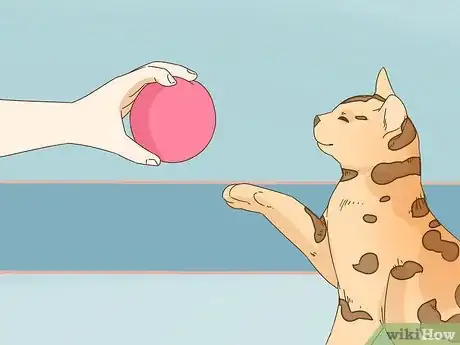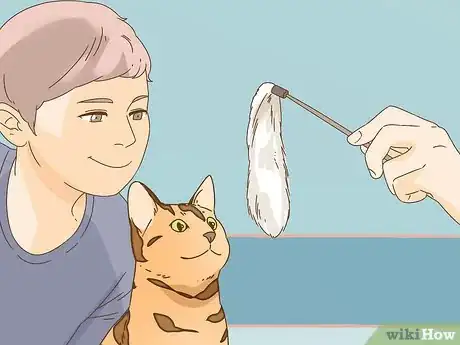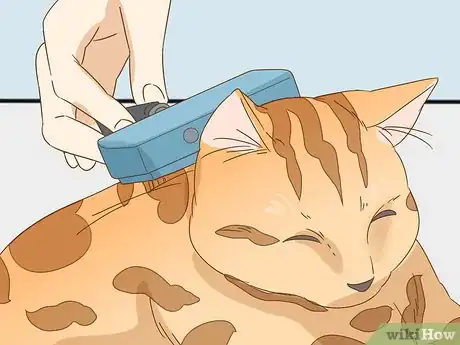This article was co-authored by Pippa Elliott, MRCVS. Dr. Elliott, BVMS, MRCVS is a veterinarian with over 30 years of experience in veterinary surgery and companion animal practice. She graduated from the University of Glasgow in 1987 with a degree in veterinary medicine and surgery. She has worked at the same animal clinic in her hometown for over 20 years.
There are 12 references cited in this article, which can be found at the bottom of the page.
This article has been viewed 36,971 times.
Bengals are gorgeous, playful cats, and they make great pets. Since they’re so energetic and intelligent, they do demand a lot of attention. To keep your feline friend happy, spend lots of quality time with it. Play and cuddle together, and provide toys, perches, and scratching posts to enrich its environment. A healthy pet is a happy pet, so take your cat to the vet annually, feed it a balanced diet, and keep it clean and well-groomed.
Steps
Bonding with Your Bengal
-
1Spend as much quality time with your cat as possible. Bengal cats crave attention, and your pet will misbehave if you don’t interact with it. From playtime to regular cuddle sessions, spend plenty of time together to show your cat how much you love it.[1]
- As intelligent as they are, mischievous Bengal cats can figure out how to open drawers, take things apart, and hide jewelry and other valuables. Giving your cat positive attention and keeping it from getting bored can spare you lots of frustration.[2]
-
2Play with your cat regularly so it can burn off energy. When you play together, encourage your cat to pounce, hide, and chase as it would in the wild. Play with an assortment of stimulating toys, such as feathers on wands, laser pointers, balls, and fake mice. Objects like cardboard boxes and paper can also entertain cats, provided your pet doesn’t try to eat them.[3]
- In addition to strengthening your bond, playing together will help keep your cat out of trouble. Since Bengals are so energetic, they tend to become destructive if they don’t get enough exercise.
Tip: Play for 10 to 15 minutes at a time several times a day. If possible, play right before you feed your cat. This mimics hunting and satisfies your pet’s predatory instincts.[4]
Advertisement -
3Teach your Bengal how to do tricks. Bengals are highly intelligent and can be trained to do tricks, such as sit, lie down, fetch, and high five. To teach your cat to sit, for instance, hold a pea-sized treat near its face and say “Sit.” Gently guide its body into a sitting position, and give it the treat as soon as it sits.[5]
- Train your cat for 10 or 15 minutes at a time, and take a break if it loses interest or gets frustrated.
- Offer tiny tidbits during training to help prevent your cat from gaining weight.
-
4Sleep with your cat to deepen your bond. Most Bengals love to cuddle and sleep with their owners. For cats, sleeping together communicates trust, so it’s one of the best ways to bond with your best bud.[6]
- Keep in mind cats are active at night, so it’ll probably leave the bed at some point. It’s a good idea to leave your bedroom door open or cracked so it can explore the rest of the home.
-
5Give your cat space when it wants to be left alone. While Bengals love spending time with their owners, all cats need their space. Don’t try to play with your cat if it’s not interested, wake it up if it’s sleeping, or force it to cuddle if it doesn’t want to be held.[7]
- Notice if your cat’s tail is wagging, ears are pinned back, or back is hunched, which indicate stress. If it displays these behaviors, hisses, or growls, give it some space.
- Additionally, never try to startle your cat or grab it by surprise.
-
6Teach your kids how to safely play with a cat, if you have any. Bengals do well with school-age kids who know how to handle pets carefully. Show your child how to get the cat comfortable by letting it sniff their finger. Demonstrate how to play with your pet by waving around feathers on wands and other interactive toys.[8]
- Explain that they should never forcefully pet or grab the cat, and teach them how to gently scratch a cat's head, ears, and neck. Remind them to give the cat space if it hisses, growls, or otherwise seems stressed.
- If you have a toddler, always supervise them when they interact with any pet. Young children may be too rough for a fragile kitten or aggressive adult cat.
Enriching Its Environment
-
1Get your cat a companion if you don't spend much time at home. If you have a busy schedule, a pair of cats can keep each other entertained and out of trouble. If you already have a Bengal and it seems to be bored, consider getting another cat to keep it company.[9]
- Keep in mind you should make sure you have the time to offer proper care before committing to a pet.
- Generally, Bengal cats get along with other pets. They love to play, so they do better with other Bengals and active small or medium dogs. Energetic Bengals tend to agitate pets that aren't into playtime.
-
2Give your cat interactive toys to keep it occupied. When you’re not around to play with your Bengal, keep it busy with puzzles, activity centers, and other interactive toys. Bengals tend to get mischievous when they’re bored, so you’ll need to make sure your pet entertained when you’re away from home.[10]
- Cat activity centers are products with moving parts, textured surfaces, and noisemakers designed to keep a cat entertained.
-
3Keep multiple climbing perches in your home. Invest in a cat tower or tree, or set up a wall of cat shelves for your Bengal. Installing a perch on a window sill can also give your furry friend a nice, high place to sunbathe.[11]
- Bengals love to climb and survey their turf. Providing safe towers, shelves, and perches can help keep your cat from knocking things over or getting hurt by climbing where it shouldn’t.
-
4Provide your Bengal with scratching posts. All cats need scratching posts to keep their claws healthy. Keeping a scratching post in your pet’s play area will also help keep it entertained when you’re not nearby.[12]
- A scratching post can also prevent your cat from damaging your furniture. If it does have issues with scratching the sofa, try spraying your cat lightly with water to deter the behavior.
- Trimming its nails every 1 to 2 weeks can also help minimize the damage caused by scratching. Never declaw a cat; most vets and animal organizations advise that declawing is unhealthy and lowers a cat’s quality of life.[13]
-
5Let your cat play in a tub or kiddie pool once or twice a month. Believe it or not, most Bengals love playing in water. If your cat is fond of the water, let it go for a swim in the tub or in a kiddie (or kitty!) pool at least once or twice a month. To make tub time even more fun, place toys in the water for your cat to hunt.[14]
- To keep your pet safe, fill a tub or pool with just 3 or 4 inches (7.6 or 10.2 cm) of lukewarm water. Avoid letting your cat jump in the tub or shower with you, as the hot water could burn it.
- Your cat's behavior will help you gauge how often to let it play in water. If it constantly tries to get in sinks, tubs, or toilets, supervised swimming sessions every 1 to 2 weeks can help keep it out of trouble. If it doesn't like water, on the other hand, don't force it to swim.
-
6Use caution if you choose to let your cat outside. If you choose to let your cat outside, it’s best to keep it in an enclosure, like a patio or cat run. Otherwise, train it come back inside when it’s called, microchip it, and place a collar on its neck with your contact information just in case it gets lost.[15]
- To train your cat to come, let it outside for about 10 minutes before a meal, then call it and offer it food. If its regular meal doesn’t get its attention, go with a treat with a strong odor, such as tuna.
Keep in mind: Vets and pet organizations recommend keeping cats indoors at all times. Additionally, since Bengals are so playful and energetic, there’s a higher risk that your cat could fight with other animals if it goes outside.
Keeping Your Cat Healthy
-
1Vaccinate your cat according to your local laws and vet's advice. At a minimum, make sure your pet receives legally required core vaccinations, such as against rabies. Additionally, consult your cat’s vet about vaccines that aren’t legally required but may be needed for your location and cat’s lifestyle.[16]
- In addition to vaccinating your cat, it’s wise to give it regular flea and tick preventative treatments.
-
2Take your cat to the vet at least once a year. To find an experienced vet, check with your local Bengal cat club, get a referral from your cat’s breeder, or search online. Regular checkups are an essential part of keeping your feline friend happy and healthy.[17]
Watch for breed-specific health issues: Bengals are prone to kidney issues, hip dysplasia, eye problems, and heart disorders. Call the vet if you notice any unusual symptoms, such as changes in appetite, energy levels, or urination.[18]
-
3Feed your cat a healthy, balanced diet. Bengals are prone to obesity-related issues, so it’s best to offer scheduled meals instead of free-feeding your pet. To meet its needs, give your cat a commercial cat food labeled for its age range. As a rule of thumb, feed your Bengal 24 to 35 calories per pound of weight (about 11 to 16 calories per kilogram) each day.[19]
- Calorie contents vary, so check food labels to calculate the amount to feed your cat. For example, an average Bengal weighs 10 lb (4.5 kg) and needs 240 to 350 calories per day. A 5.5 oz (156 g) can of wet cat food usually contains 130 to 175 calories, so 2 cans per day would meet your cat's needs.
- Avoid giving your cat table scraps, and don’t give your cat too many treats. Treats should make up no more than 10% of its diet.
- Additionally, make sure your cat has access to clean water at all times.
-
4Comb your cat’s fur weekly. Bengals are relatively low-maintenance; simply brush its coat once a week to remove dead fur. Regular brushing will also cut down on shedding and hairballs.[20]
- In addition to keeping its coat healthy, grooming your cat will help reinforce your bond.
- When you brush your cat, check its eyes, nose, and ears for redness or discharges, feel its body for unusual lumps, and look through its fur for fleas and ticks.
-
5Scoop up soiled litter daily and deep clean the litter box weekly. Cats are clean animals, and a messy litter box will stress out your pet. Scoop up solid waste and soiled litter every day, and deep clean the box once a week. To deep clean it, dump everything out of it, wash it with a mild soap, and thoroughly rinse it with hot water.[21]
- After cleaning it, dry the box with paper towels or let it air dry, then refill it with litter. If your home has more than 1 floor, keep a litter box on each level. Be sure to clean each of your cat's litter boxes regularly.
Warnings
- Only purchase a Bengal cat from a responsible breeder and make sure that they socialize their kittens from a young age.⧼thumbs_response⧽
- Before getting a Bengal cat, make sure you’re familiar with the breed’s specific. Bengals are high-energy, intelligent, and demand lots of attention.[23]⧼thumbs_response⧽
References
- ↑ https://vcahospitals.com/know-your-pet/cat-breeds/bengal
- ↑ http://www.vetstreet.com/cats/bengal#personality
- ↑ http://www.vetstreet.com/cats/bengal#personality
- ↑ https://icatcare.org/advice/playing-your-cat
- ↑ http://www.vetstreet.com/cats/bengal#personality
- ↑ https://www.tica.org/breeds/browse-all-breeds/79-breeds/824-bengal-breed
- ↑ https://www.bluecross.org.uk/pet-advice/how-play-your-cat
- ↑ https://www.americanhumane.org/fact-sheet/cats-kids-2/
- ↑ http://www.vetstreet.com/cats/bengal#personality
- ↑ http://www.vetstreet.com/cats/bengal#personality
- ↑ https://vcahospitals.com/know-your-pet/cat-breeds/bengal
- ↑ https://www.aspca.org/pet-care/cat-care/general-cat-care
- ↑ https://www.aspca.org/about-us/aspca-policy-and-position-statements/position-statement-declawing-cats
- ↑ https://cattime.com/cat-breeds/bengal-cats
- ↑ https://www.humanesociety.org/resources/10-tips-keep-your-cat-happy-indoors
- ↑ https://www.aspca.org/pet-care/cat-care/general-cat-care
- ↑ https://www.aspca.org/pet-care/cat-care/general-cat-care
- ↑ http://www.vetstreet.com/cats/bengal#health
- ↑ https://bengalcatclub.com/bengal-cats-complete-guide/
- ↑ https://cattime.com/cat-breeds/bengal-cats
- ↑ https://www.aspca.org/pet-care/cat-care/general-cat-care
- ↑ https://cattime.com/cat-breeds/bengal-cats
- ↑ https://bengalcatclub.com/bengal-cats-complete-guide/
About This Article
To keep a Bengal cat happy, play with it for 10-15 minutes several times a day, which is important with Bengal cats since they have so much energy. Also, make sure your cat has plenty of interactive toys, climbing perches, and scratching posts so it doesn't get bored or lonely when you're not at home. You should also feed your Bengal cat a healthy, balanced diet and provide it with plenty of fresh water so it stays healthy and happy for years to come. To learn how to groom your Bengal cat, scroll down!













































































